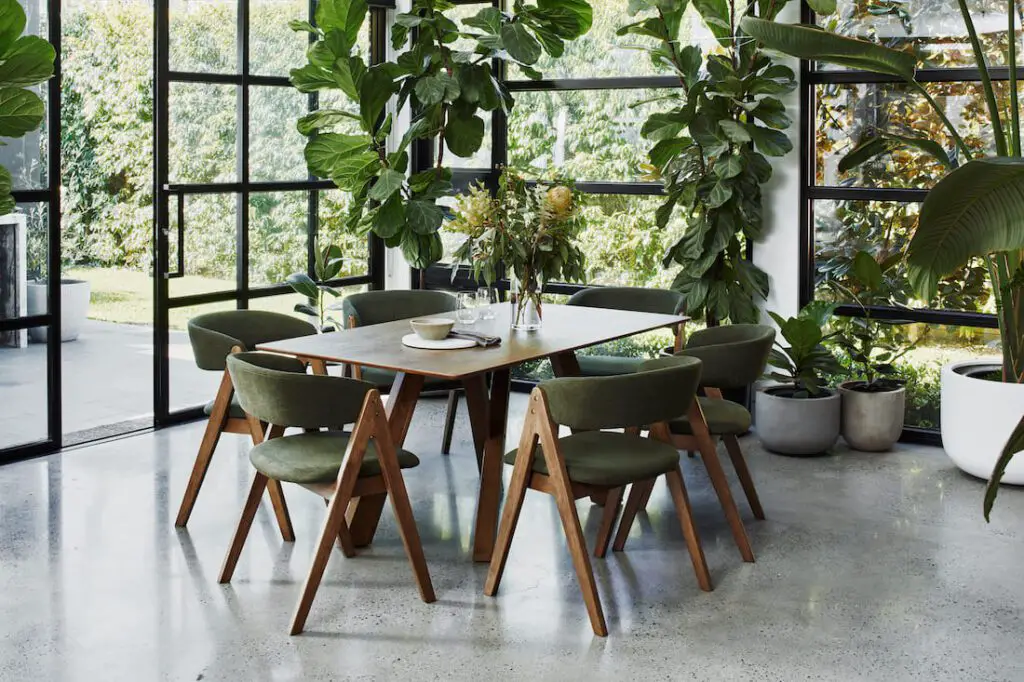In today’s eco-conscious world, the design of your dining room can serve as a reflection of your commitment to sustainability and style. Transforming your dining area into an eco-friendly space does not only contribute to environmental conservation but also offers a unique, chic aesthetic that can elevate your home. Here’s how you can achieve a sustainable yet stylish dining room that combines functionality, eco-friendliness, and elegance.
Choosing Sustainable Materials
The foundation of any eco-friendly dining room is the materials used. Opt for furniture made from reclaimed wood, which reduces the demand for virgin timber and the environmental impact associated with logging. Reclaimed wood also adds character and history to your dining space, making each piece a unique conversation starter.
Bamboo is another excellent material—it grows quickly, making it a highly renewable resource. Bamboo furniture is not only durable but also has a sleek, modern look that can complement any dining room.
Consider Eco-Friendly Flooring
Flooring is another critical aspect of your dining room design. Cork flooring is one of the best eco-friendly options available. It is harvested from the bark of cork oak trees without causing any harm to the tree itself, which means it is renewable. Cork is also biodegradable and recyclable, adding to its sustainability credentials. Additionally, it provides natural insulation, reducing energy costs in your home.
Linoleum, made from linseed oil, wood flour, and cork dust, is another sustainable choice. It’s durable, easy to clean, and available in various colors and patterns, allowing you to customize the look of your dining room effortlessly.
Energy-Efficient Lighting
Lighting plays a pivotal role in setting the mood of any room, including your dining area. Opt for LED lighting which is up to 80% more efficient than traditional lighting. LED lights last longer, which means fewer replacements and less waste. Consider installing a dimmer switch to adjust the lighting based on the time of day or the ambiance you want to create, further saving energy.
Eco-Friendly Table Settings
Tableware also contributes to your dining room’s eco-friendliness. Choose ceramic plates, bowls, and dishes made from natural materials. Avoid plastic and opt for glass, bamboo, or metal cutlery. For a truly sustainable table setting, use cloth napkins instead of paper, and consider fair-trade certified textiles to ensure that your purchases support sustainable production practices.
Decorating with Plants
Incorporating plants into your dining room not only adds a splash of color and life but also improves indoor air quality. Plants like spider plants, peace lilies, and ferns can filter out common pollutants and add a fresh, vibrant feel to your dining space.
Wall Paints and Finishes
When it comes to painting your dining room, opt for low-VOC or zero-VOC paints. These paints have reduced levels of volatile organic compounds, which means they do not release toxins into the air, maintaining better indoor air quality.
Antique and Vintage Accents
Using antique or vintage decor items not only gives your dining room a unique flair but is also a form of recycling. These pieces add an element of timeless elegance and character that cannot be replicated by new items. By reusing old furniture and decor, you reduce waste and demand for new materials.
Adopting a Minimalist Approach
A minimalist approach can help emphasize sustainability in your dining room. By choosing fewer, high-quality pieces, you reduce clutter and focus on items that offer both function and style. This approach encourages purchasing items that are made to last, reducing waste and promoting a cycle of use and reuse.
Conclusion
Creating an eco-friendly dining room is about making conscious choices—from the materials you choose to the way you light the room. By opting for sustainable materials, energy-efficient solutions, and eco-friendly decor, you not only create a stylish and welcoming dining space but also contribute to the well-being of the environment. Remember, each small step can lead to significant changes.


